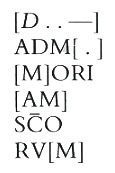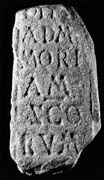Select a site alphabetically from the choices shown in the box below. Alternatively, browse sculptural examples using the Forward/Back buttons.
Chapters for this volume, along with copies of original in-text images, are available here.
Object type: Part of cross-shaft [1]
Measurements: H. 55.9 cm (22 in); W. 28.6 cm (11.25 in); D. 21 cm (8.25 in)
Stone type: Coarse-grained, feldspathic, very pale brown (10YR 7/4) grit; Millstone Grit, Namurian, Upper Carboniferous; probably reused Roman ashlar, originally from Hetchell Crag (Thorner) or Otley areas (see Fig. 5).
Plate numbers in printed volume: 365-368
Corpus volume reference: Vol 3 p. 108-109
(There may be more views or larger images available for this item. Click on the thumbnail image to view.)
Inscription One of the broad faces carries an inscription in capitals which is further discussed in Chap. 12 (pp. 00–00). It is set in short horizontal lines. Incised vertical lines on either side separate the inscription from framing bands down the edge of the stone. The letters, which are about 5.5 cm high, are deeply cut and very worn. The text, which is in Latin, is incomplete at the beginning and perhaps also at the end. It reads:

The two fragmentary letters following the probable D in the first surviving line could be parts of I and square C. Probably two further letters are lost to the right. The line might have read something like DICAT, or possibly DICATA, although five letters would fit the line more comfortably than six. These reconstructions would give either the third person singular or the past participle of a first conjugation verb, probably dedicare or simply dicare, both of which have the sense of 'to dedicate'. With these conjectural restorations the text would then read: — [DE?]D[ICAT?] AD M[E]MORIAM S(AN)C(T)ORVM —, or — [DE?]D[ICATA?] AD M[E]MORIAM S(AN)C(T)ORVM — (Translation: '— dedicates (?) . . .', or 'dedicated (?)', 'in memory of the saints —' or '. . . of the holy —'.) Roman capitals or their derivatives are used. The non-Classical forms are: square C; open-bowed R; and angular S. Syllabification is regular. The nomen sacrum shown below, marked with a bar, is correctly used for s(an)c(t)orum:

==J.H.
B-D: Plain.
Inscription This decoratively austere shaft is in the tradition of plain inscribed monuments at Hexham, Northumberland, Hornby and Lancaster, Lancashire, Ripon, West Riding, and Whitby and Wycliffe, North Riding (cf. Chap. 12, p. 45). The non-Classical letter forms are all common ones, both in early and late Anglo-Saxon inscriptions (Okasha 1968). The inscription may be evidence that the cross was a funerary monument. Alternatively the probable reference to saints may indicate that the cross commemorated two or more, perhaps local, saints in some way (cf. Chap. 12, p. 45).
==J.H.



